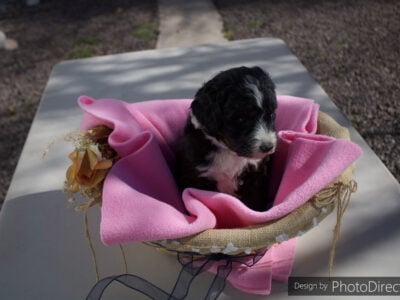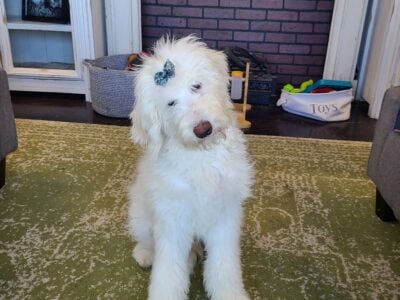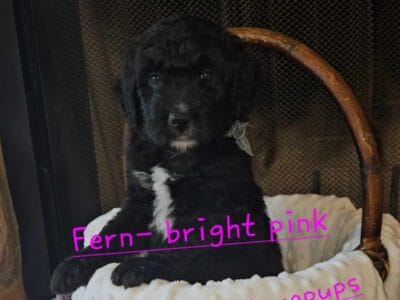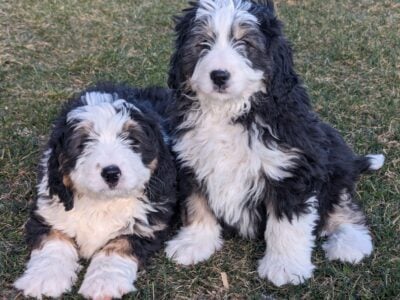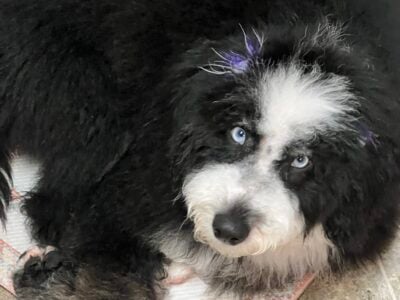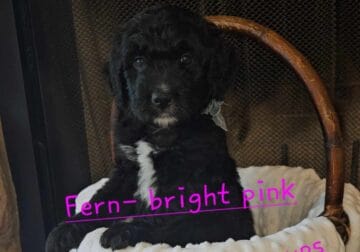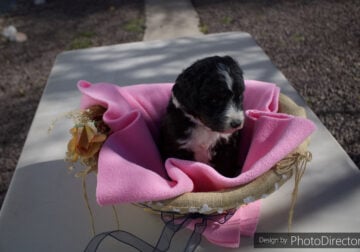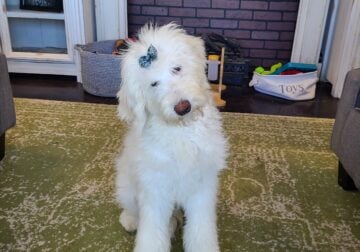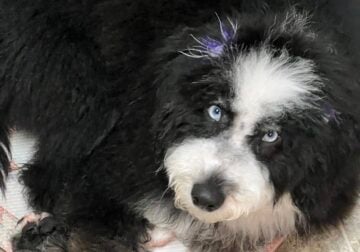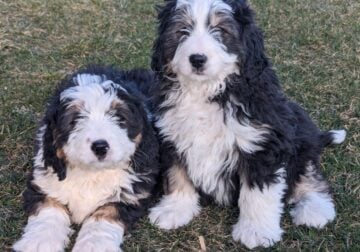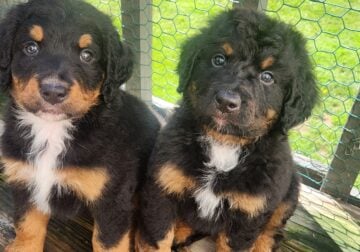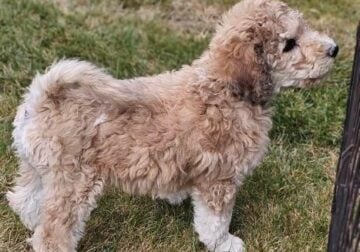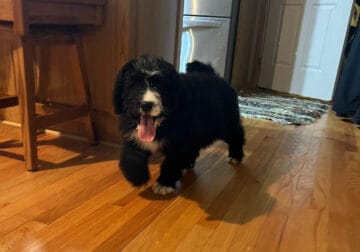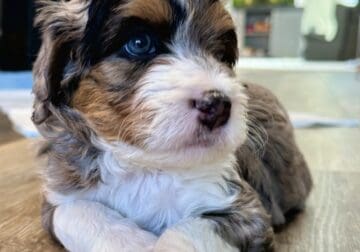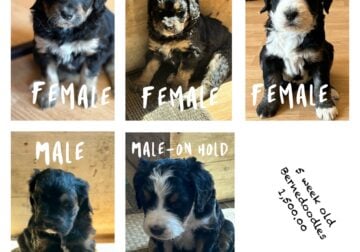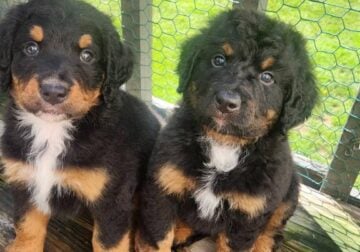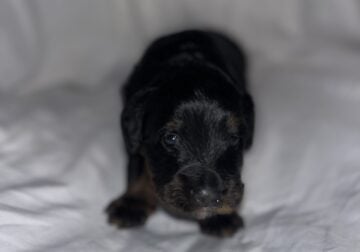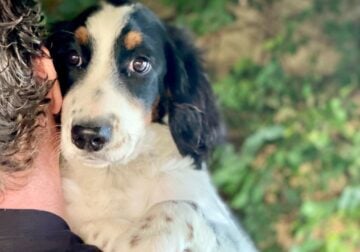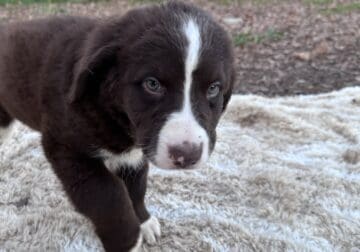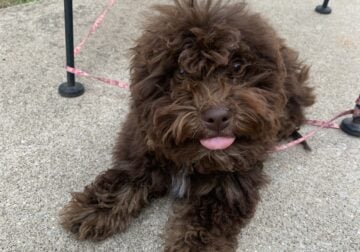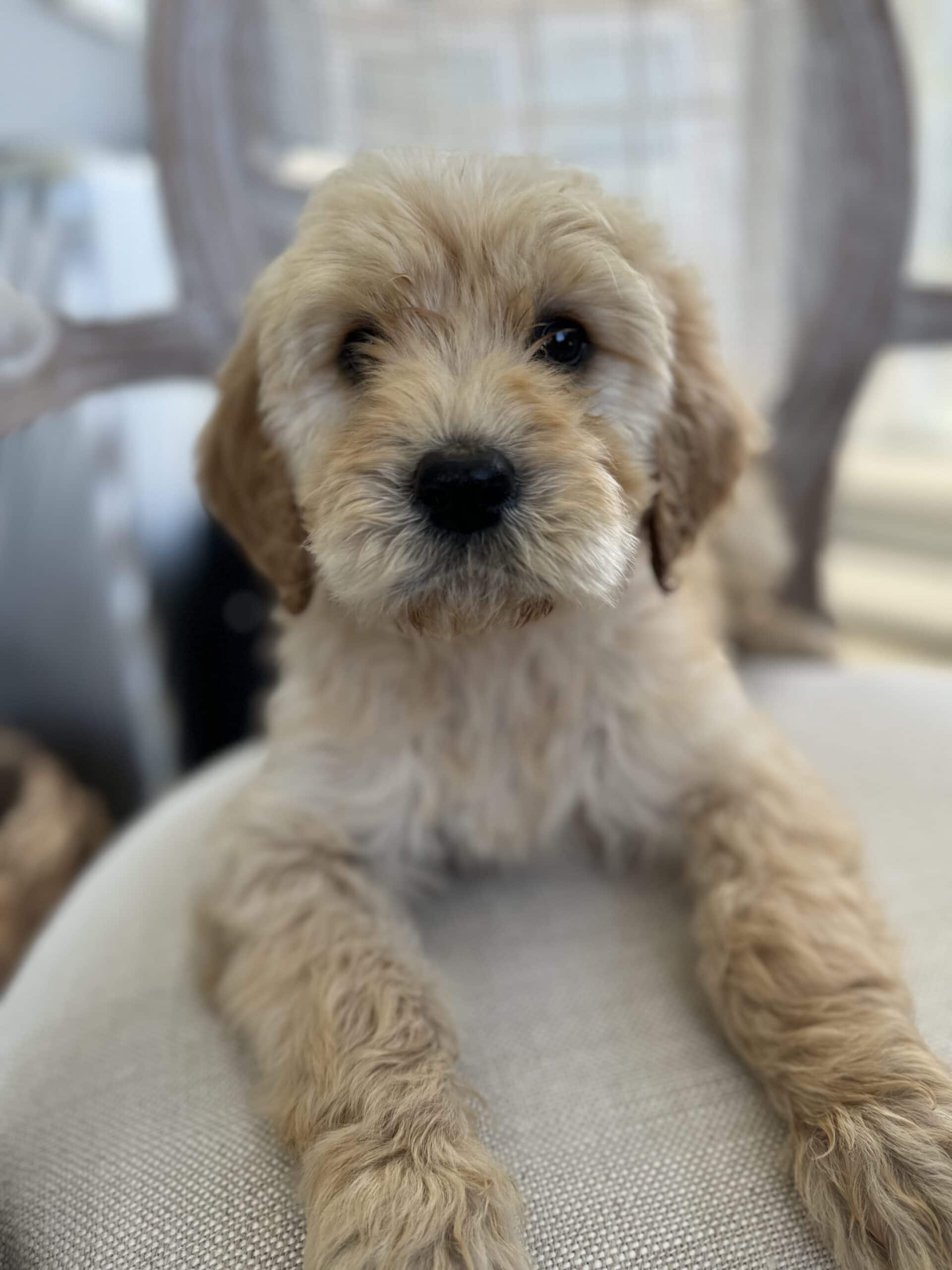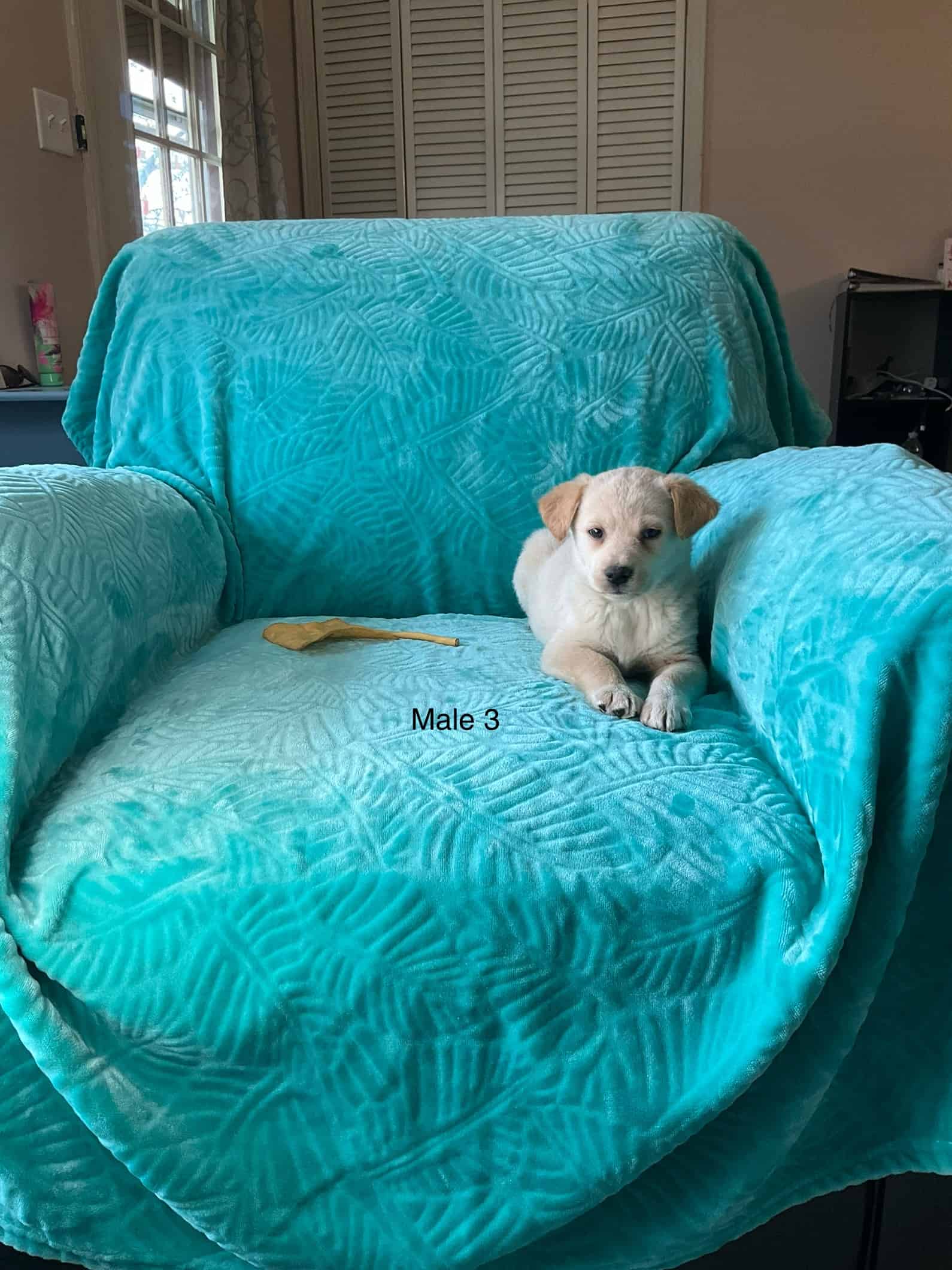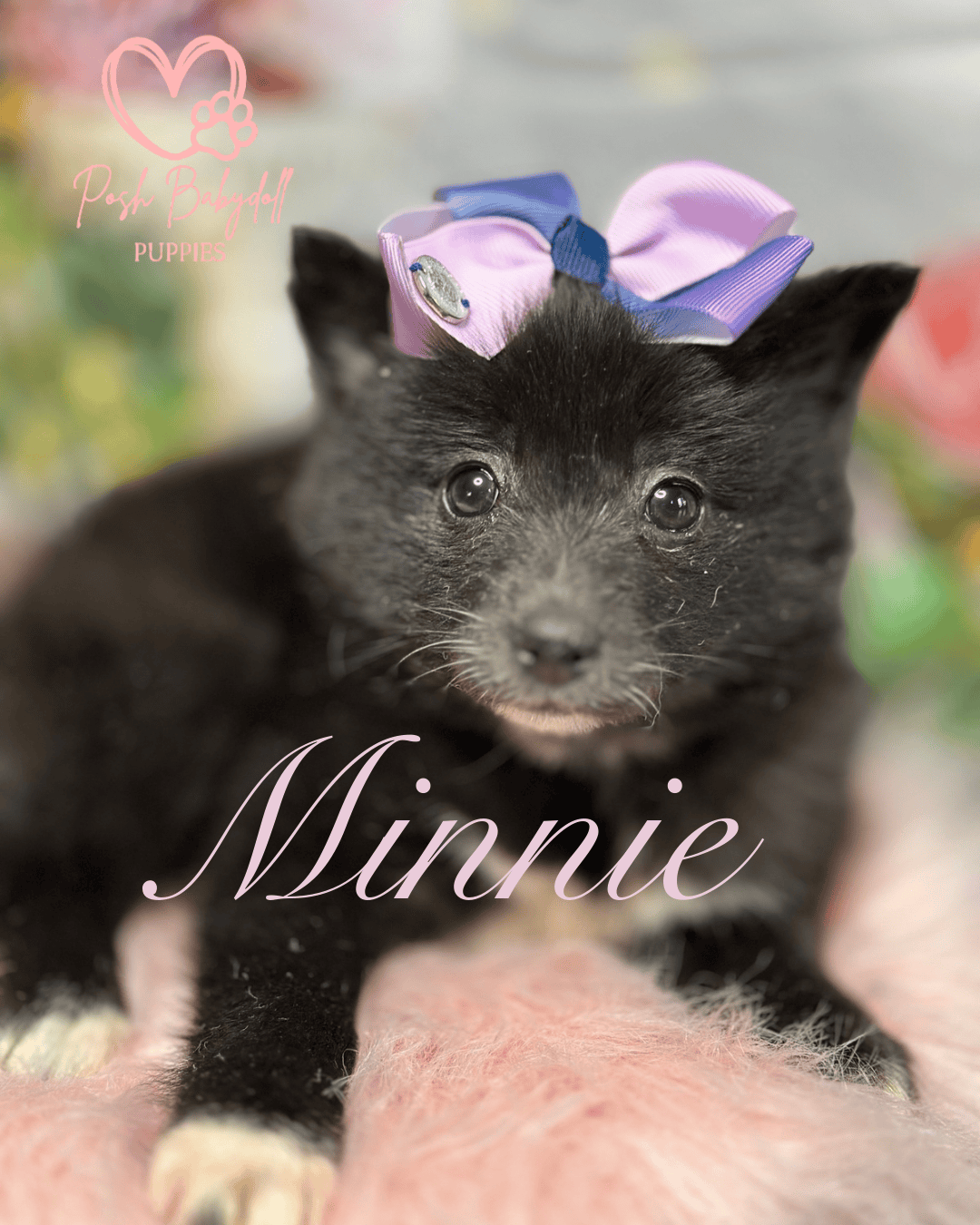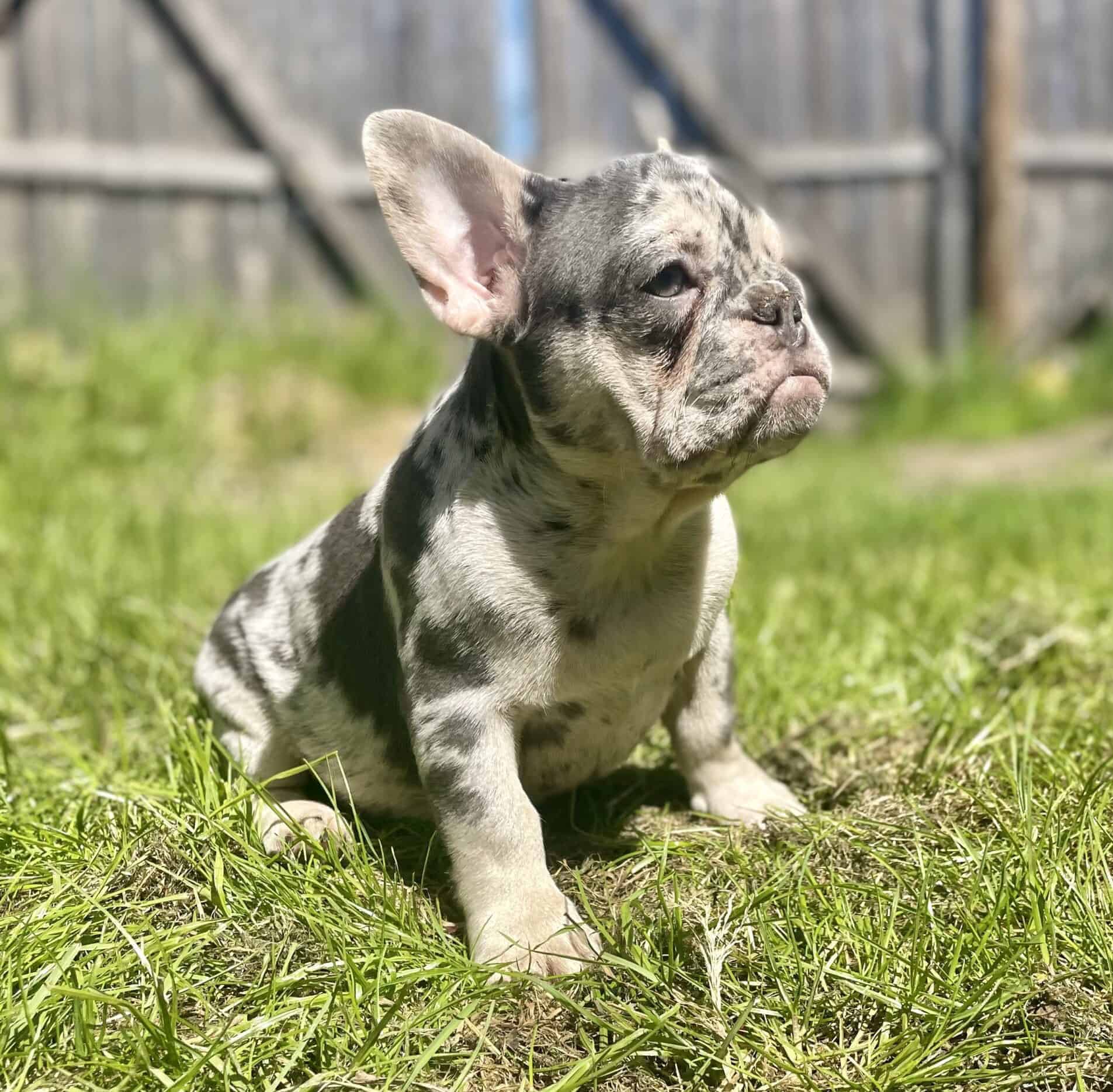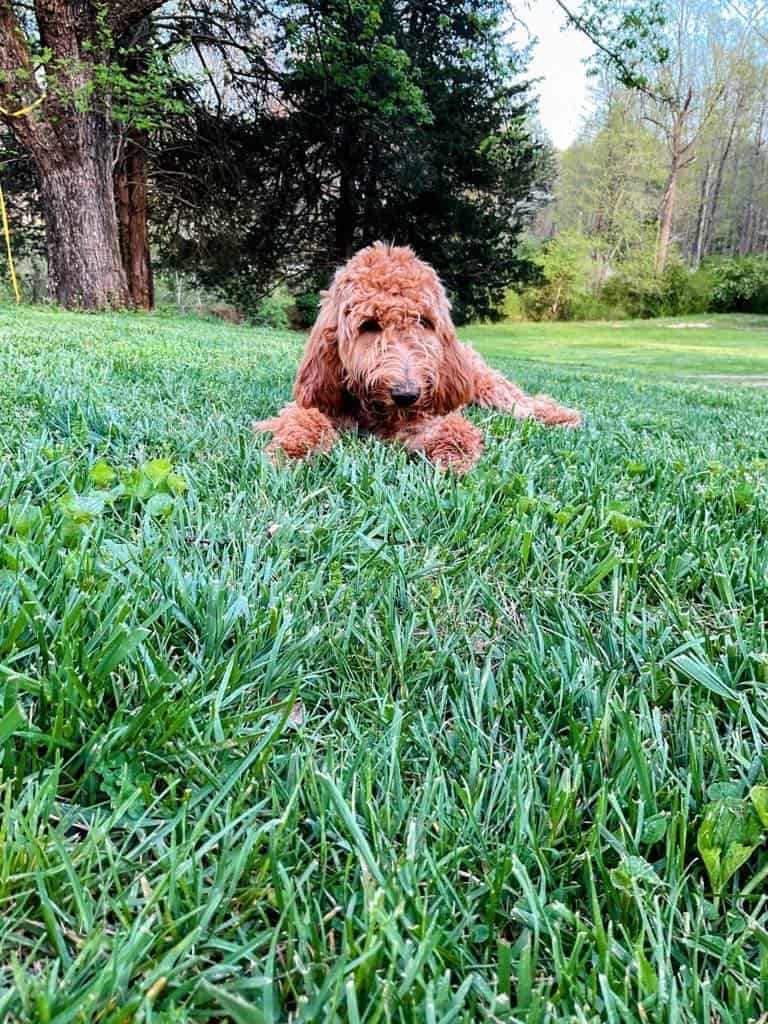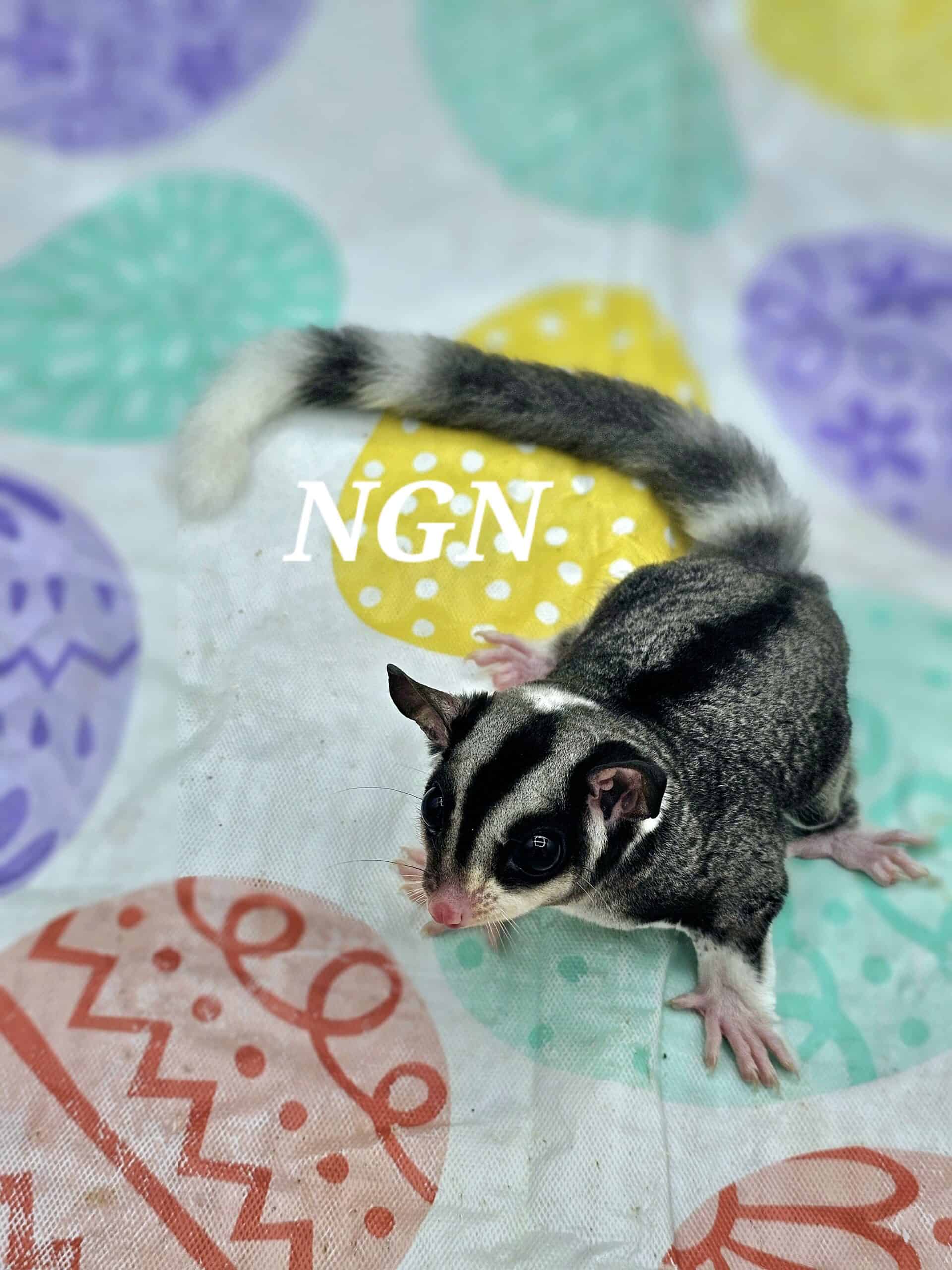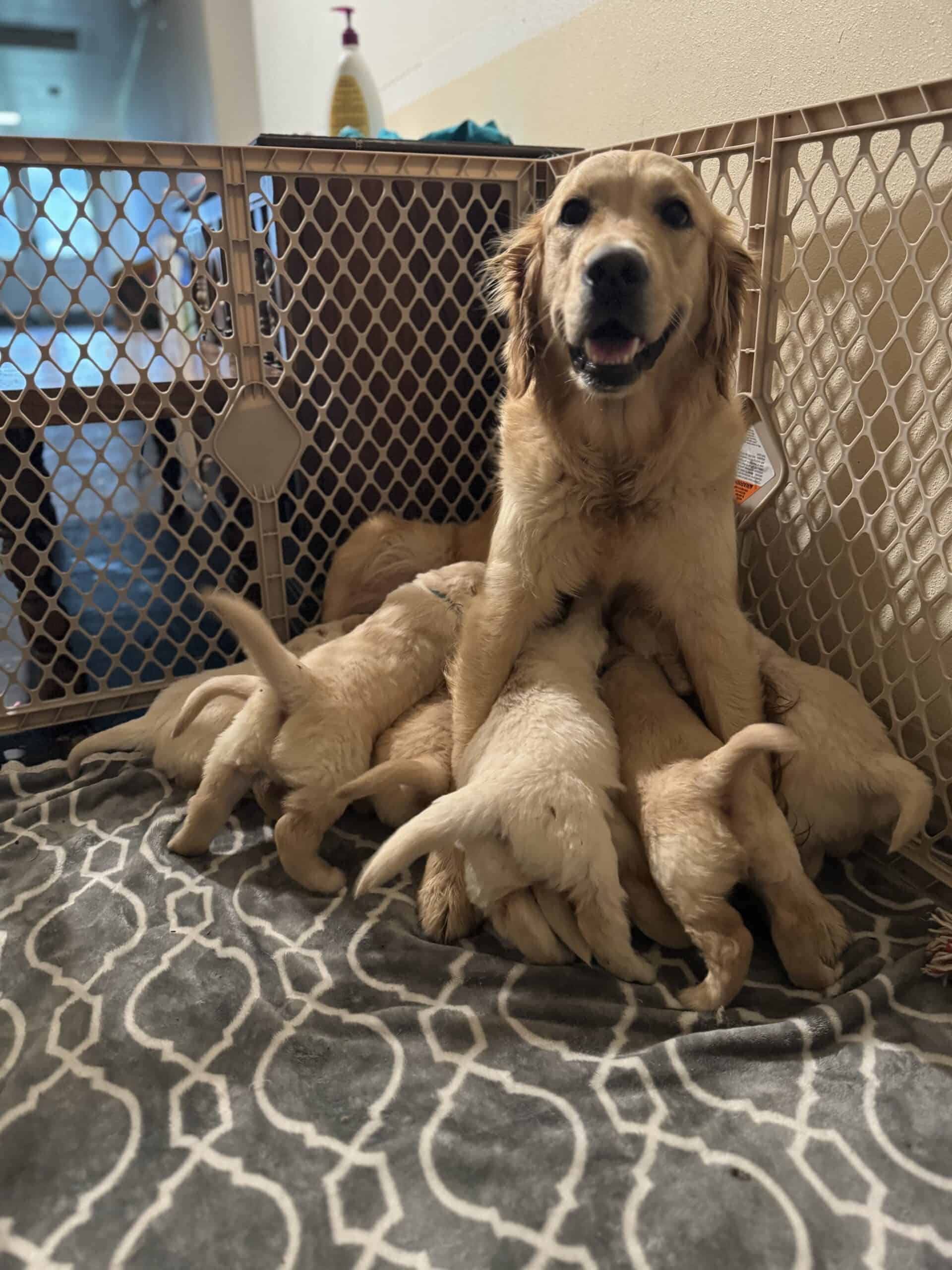Popular Filter:
Bernedoodle under $1,000
Bernedoodle Puppies for Sale $1500.00
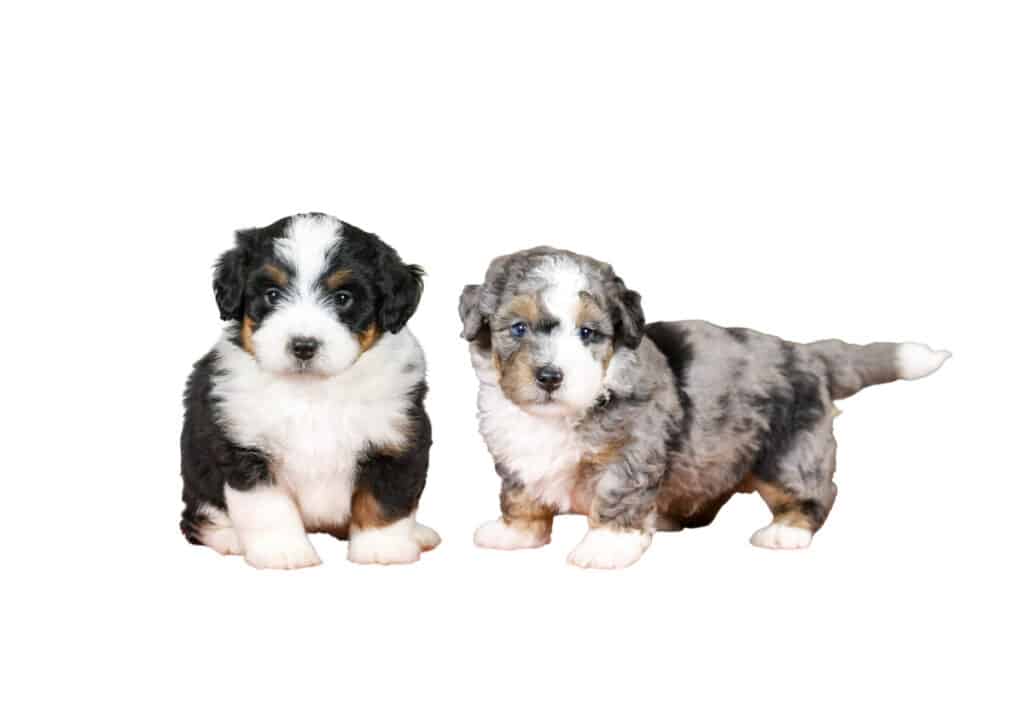
An Unusual Mix that Works: Bernedoodle Puppies for Sale
The result of an unlikely cross between a water dog from Germany (Poodle) and a livestock drover and family guard dog of the Swiss Mountains (Bernese Mountain Dog), the Bernedoodle originated in Canada around 2003. This designer breed continues to serve its original purpose as a hypoallergenic companion dog. If you need a loving yet active pet, Bernedoodles are energetic, affectionate, healthy, and engaging. They love children and mesh well with other dogs. Your biggest challenges will be socialization and grooming.
What Should a Bernedoodle Look like?
When they are nine weeks old, Bernedoodle puppies for sale are cute and look easy to manage. However, every prospective owner is curious about how they will look when they mature.
Size
The Bernedoodle’s size is quite variable, usually determined by the size of the Poodle parent. A standard Bernedoodle, a cross between a BMD and a Standard Poodle, is 23 to 29 inches tall and weighs 70 to 90 pounds. Miniature and Toy versions also exist.
Physical features
The Bernedoodle is a hybrid and thus has unpredictable physical characteristics. There is a world of difference between the light-framed Poodle and the heavy-boned Bernese Mountain dog. Multigenerational dogs begin to have a more consistent appearance than first-generation crosses. Most Bernedoodles have the typical “Doodle” elongated head with dark, oval-shaped soulful eyes and hanging ears. They also have a compact square-shaped body and upright brushtail. Dogs with a greater Bernese influence will be heavier with a body that is longer than it is tall.
Coat
A Bernedoodle can have a variable coat. Third and fourth generations produce much more consistent coats, typically wavy or loosely curled with low-shedding and hypoallergenic properties. Bernedoodles have coats that provide cooling in the summer and insulation in the winter. The coat also protects against moisture. Typically, a Bernedoodle does better in cold weather than the Poodle and withstands warmer conditions better than the purebred BMD.
Colors
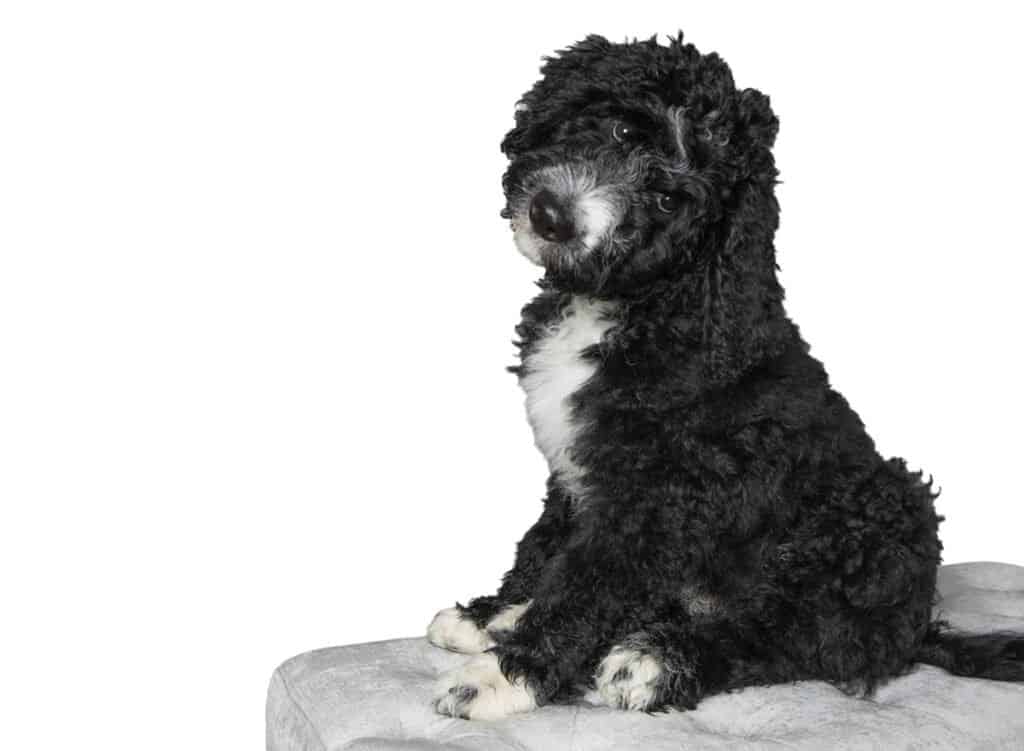
Bernedoodle puppies for sale have the plethora of coat colors of the Poodle as the Bernese is only tricolor.
- Solid black
- Black sable – Base color is brown with black-tipped hairs
- White
- Apricot
- Red
- Cream
- Black and brown
- Black and white
- Tricolor – Pattern may not be as stereotypical as purebred BMD; Black with tan points and white spotting pattern
- Tan
- Chocolate
- Blue – Dilute or muted black
- Grey – Different gene than blue
Temperament
Bernedoodles are excellent family pets by most accounts. They get along with other dogs, children, and visitors. They tend to be more protective than most of the other common Doodles. With proper socialization, Bernedoodles should accept your guests with ease. Although tolerant and patient of younger children, a Bernedoodle’s size and energy level always require supervision. A low prey drive means Bernedoodles have the potential to get along well with cats they live with.
- Affectionate
- Goofy or clownish
- Like to play
- Loyal
- Work ethic present – Prefer to have a job
Information About Bernedoodle Generations
Multigenerational Bernedoodles have the advantage of producing more consistencies in some desirable characteristics. Typically, the first generation has a wider variety of coat types and temperaments. Breeders will perform a backcross of a dog from a hybrid litter to a purebred. Ultimately, in some breeds like the Labradoodle, dogs will only come from generations of Doodle x Doodle crosses. Each generation of crosses has a designation.
- F1 –> Poodle x Bernese Mountain Dog (50% Poodle, 50% BMD); Coat is variable and can be straight and flat like a BMD, wavy, or curly
- F1B Bernedoodle –> F1 Bernedoodle x Bernese Mountain Dog or F1 Bernedoodle x Poodle (75% Poodle, 25% BMD); Coat wavy or loose curls, low-shedding
- F1BB Bernedoodle –>F1B Bernedoodle x Bernese Mountain Dog or F1B Bernedoodle x Poodle (87.5% Poodle, 12.5% BMD); Most likely curly coat, non-shedding
- F2 Bernedoodle –> F1 Bernedoodle x F1 Bernedoodle (50% Poodle, 50% BMD); Most unpredictable coat type, greatest availability of gene combinations, not a common goal of Bernedoodle breeders
- F2B Bernedoodle –> F1 Bernedoodle x F1B Bernedoodle (62.5% Poodle, 37.5% BMD) or F1B Bernedoodle x F1b Bernedoodle (75% Poodle, 25% BMD); Mostly wavy or curled low-shedding coat; Rare flat straight coat
- F2BB Bernedoodle –> F2B Bernedoodle x Bernese Mountain Dog or F2B Bernedoodle x Poodle (81.25% Poodle, 18.75% BMD); Usually curly low-shedding coat
- F3 Bernedoodle –> F2 Bernedoodle x F2 Bernedoodle
Most backcrosses, designated by the letter B in the generation code, are with Poodles because people seek the hypoallergenic qualities of the Poodle’s coat. Bernese Mountain Dogs add softness or plushness to the Poodle’s typically hard curls. Most dogs have looser curls than purebred Poodles with some simply having pronounced waves. F3 dogs usually represent one or more backcrosses with a Poodle. Going forward, Bernedoodle breeders invariably back breed multigenerational dogs to Poodles to maintain the desired coat quality. The above percentages assume Poodle backcrosses, but some dog owners prefer the larger size and flat dual coats of the BMD crosses. Bernese Mountain Dog backcrosses are more difficult to find.
Facts About the Mini Bernedoodle
Mini Bernedoodles are not pocket or teacup dogs but are substantially smaller than the standards. A Mini Bernedoodle is about 18 to 22 inches tall at the shoulders and only weighs 25 to 50 pounds. Minis are the product of pairing a Miniature or Toy Poodle with a Bernese Mountain Dog. Typically, Miniatures make a better match because using Toy Poodles sometimes results in exaggeratedly long backs and dwarfed legs. Toy Poodle crosses can sometimes produce Toy Bernedoodles which can be as small as ten pounds. Bernedoodles also tend to become smaller with subsequent backcrosses to Poodles over the generations except with the exclusive use of Standard Poodles. Unlike many other downsized dogs, Miniature Bernedoodles have better health and a longer lifespan than their standard counterparts. They can live 12 to 18 years.
Bernedoodle vs Goldendoodle
Starting with their similarities, both the Bernedoodle and Goldendoodle are increasingly popular designer dogs that come in three sizes. Both were “designed” to be companion dogs with stable temperaments and low-shedding and hypoallergenic coats. Goldendoodle breeders also hoped the breed would perform well as a seeing-eye dog, and it does. Bernedoodles are usually larger than Goldendoodles with a greater variety of colors. Goldendoodles can be red, apricot, red sable, blue sable, or brindle. Bernedoodles also tend to be quieter and more protective than Goldendoodles. Mini Goldendoodles are 13 to 20 inches tall and weigh 15 to 35 pounds. A small Standard Goldendoodle, equivalent to a Mini Bernedoodle, is about 17 to 20 inches tall and weighs 40 to 50 pounds. Finally, a Standard Goldendoodle is 18 to 23 inches tall and weighs 35 to 60 pounds. Standard Goldendoodles live 10 to 15 years while Standard Bernedoodles have a similar life expectancy of about nine to fourteen years. Bernedoodle puppies for sale can command slightly higher prices at $2000 per pup compared to $1500 for a Goldendoodle.
Australian Bernedoodle
Any discussion of the Australian Bernedoodle requires an introduction of the Australian Labradoodle. An Australian Labradoodle is quite different from its American counterpart. The American Labradoodle is still often a Poodle x Labrador Retriever cross. An Australian Labradoodle is almost always a multigenerational dog with strong efforts by breeders to cross the purebred threshold. Australian Labradoodles, like American Labradoodles, began with Labrador x Poodles crosses. Dogs were bred to the F3 cross which was then mated with purebred Poodles. During this progression, breeders also introduced Cocker Spaniel, Irish Spaniel, and Cockapoo bloodlines to standardize the size of the dog and add quality to the coat. Some individuals also had seen Poodle backcrosses before they reached their F3 status. An Australian Bernedoodle is a Bernese Mountain Dog x Australian Labradoodle cross, a far cry from the American variety. They range from 17 to 21 inches tall and 35 to 50 pounds. They are commonly tricolor like a BMD but can also be bicolor black & white, tan & white, black & tan, or cream & white. Aussie Bernedoodles live 12 to 15 years and are friendly, energetic, and trainable with a great work ethic.
Bernedoodle Puppies Near me: Choosing the Right Pup
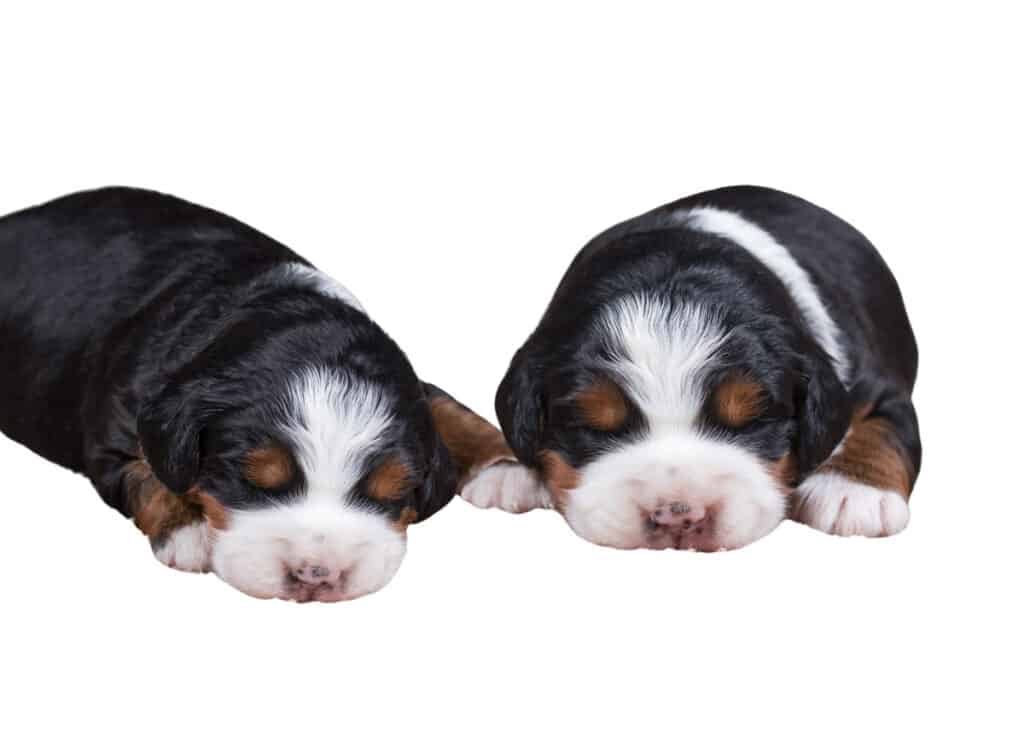
Nearby Australian Bernedoodles are always your best option if you can visit them. An in-person experience is the best way to get a hands-on feel for the health of the litter, cleanliness of the environment, and condition of one or both parents. You can pick the puppy that you seem to gravitate towards the most. You may want a certain coat color or type. Breeders can often help you pick a puppy with the right combination of colors and personality for your lifestyle or family type. Be sure to avoid withdrawn or aggressive puppies or those that appear sick with discharge around the eyes or nose or soiling around the rear end.
Health
The health of Bernedoodles appears to improve with the earlier crosses. First-generation crosses involve matches between individuals that are not closely related. The expectation is that these dogs come from a larger genetic pool and thus have decreased chances of inheriting debilitating diseases.
Caring for Your Bernedoodle
- Love – Bernedoodles are companion dogs and require constant company and frequent quality time; They do not do well on their own, becoming destructive or transforming into obnoxious barkers
- Food – Require high-quality kibble, wet food, moist and dry mix, fresh homemade meals, or raw diet with an appropriate balance of proteins, fats, vitamins, and minerals;
- Exercise – 1 to 1.5 hours per day, a mix of high-intensity, training, and low-intensity split into two sessions daily
- Training – Intelligent dog with some willfulness as a puppy; Require consistent and sensitive handling with straightforward guidance; Need variety to avoid boredom and anticipation
- Grooming – Flat coat needs brushing twice a week; Wavy coat needs brushing 3 to 4 times a week; Curly coat may require daily brushing; Doodles are not often shaved
- Nail trim every 4 to 6 weeks
- Check ears every other day
